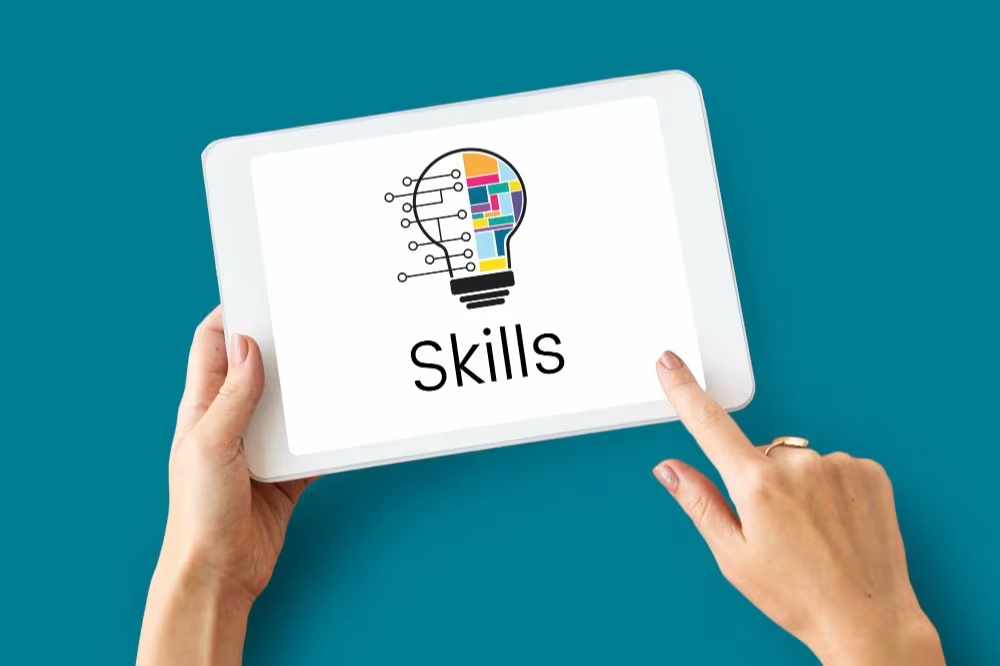Plan training the same way you did five years ago and you will waste most of it. A Gartner industry analysis comparing three strategies found that a dynamic skills approach, which senses shifts in real time and develops at the point of need, yields a 75% application rate, compared with 54% for reactive and 37% for predictive planning. This article takes a clear position. Skill development must be dynamic, enabled by managers, and embedded in work. The highest-tier evidence, including a Journal of Management meta-analysis of 159 studies and a meta-analytic review of turnover drivers from Qeios research, shows that strategic investment in skill development lifts performance and keeps people from leaving when you execute it in context.
Understanding Skill Development
At its core, skill development is a deliberate, continuous process to acquire, improve, and apply capabilities, both technical and social, to deliver better outcomes at work. The strongest proof that this work pays off comes from a large-scale Journal of Management meta-analysis that synthesized 159 empirical studies and represented 75,033 organizations. It found a positive and statistically meaningful link between organizational training and performance. The average effect is modest. The authors note that it grows substantially when training aligns to strategy, fits the knowledge intensity of the work, and targets the specific human capital you are building. Here is the bottom line for HR. Training works, and the fit to your business context determines how big the win is.
Retention effects stand out even more. A Qeios meta-analytic review spanning 23 studies reported that when employees perceive real development opportunities and competence growth, their intentions to leave drop markedly. The practical implication is direct. When employees see credible pathways to grow, they are far less likely to plan an exit.
Yet the skills landscape is shifting faster than static programs can handle. Gartner’s analysis of job data indicates the number of skills per role grows about 10% year over year. More than 30% of what was needed three years ago is fading. A SAGE Open systematic review of 154 studies further shows that research overwhelmingly emphasizes technical and information skills, while higher-order capabilities like creativity and critical thinking are underexamined. In other words, skill development must be broader and more adaptable than most portfolios today.
Assessing Your Skill Gaps
The way you assess skills either accelerates impact or locks you into irrelevance. Gartner’s dynamic approach starts with sense. You create a network of business leaders, customers, and talent analytics to detect shifts as they emerge. Replace annual inventories with monthly signal reviews from job postings, customer feedback, and internal mobility data. Treat skill development as a living system, not a library.
Go beyond inventories to motivation. A University of Houston longitudinal study of 817 new graduates found people tend to aim to improve social, emotional, and behavioral skills where they feel weakest, but prefer to build on strengths in technical domains. Use this insight in skills audits. Pair proficiency data with self-stated goals to personalize plans. Fortify SEB gaps and extend technical strengths.
Manager involvement is the bottleneck most companies ignore. An HR Dive report on Deloitte’s global trends survey industry polling reveals managers spend 13% of their time on people development, while 36% feel unprepared to manage others. Bake time and tools into your assessment rhythm. Equip managers with quarterly skill conversations, such as five focused questions on priority capabilities and upcoming deliverables. Provide simple skill heatmaps, such as a three-level rating with evidence from work samples. Set a clear escalation path to internal gigs and micro-projects. Without this backbone, skill development plans rarely translate into action.
Developing Your Skills
Formal programs matter, but the evidence shows that relevance and timing determine whether learning sticks. Gartner’s findings suggest moving from static courses to skill accelerators, which combine rapid, curated learning with immediate application. Make formal training modular, aligned to roles, and adjacent to work. Measure application within 30 to 60 days.
On-the-job learning consistently outperforms classroom equivalents when it is structured. A JMIR Human Factors mixed-methods study in hospitals compared innovating versus non-innovating organizations and found the innovators invested in cross-departmental teams, task forces, and integrated information systems. Demand rose most for transferable skills such as responsibility and quality consciousness (+72% vs. 42%), adaptation (+63% vs. 32%), and communication and cooperation (+62% vs. 32%). The lesson for any sector is clear. Create cross-functional work that forces the practice of transferable skills, not only role-specific tasks.
Skills-based volunteering is a powerful and underused development lever. A Human Resource Management Review systematic review covering 36 peer-reviewed articles found employees typically donate technical skills while gaining interpersonal ones like leadership and teamwork. One study cited 79% reporting interpersonal skill gains. Align volunteering projects with leadership pipelines. For example, design pro bono engagements that require stakeholder management, ambiguity navigation, and cross-cultural communication. Because motivations in volunteering tilt toward altruism, frame the program as community impact with personal growth as a supported outcome.
Finally, target overlooked higher-order capabilities. The SAGE Open review highlights a research gap on determinants of creativity, critical thinking, collaboration, and communication. Close it in practice by embedding short, iterative challenges, such as design sprints, debate-based problem solving, and peer critiques, into work cycles. Treat these as core skill development sprints with clear rubrics and frequent feedback.
Implementing a Skill Development Plan
Turn insight into execution with a simple cadence. Define, build, apply, and measure.
● Define goals the way high-impact organizations do that are tight, role-relevant, and market-anchored. Use SMART framing and specify the work deliverable that will prove capability, not only a course completion.
● Build through curated pathways that blend micro-learning with immediate stretch assignments. Include one to two adjacent skills to speed transfer.
● Apply within real work in 30 to 60 days. Pair every learning module with a project or rotation, and hold a manager checkpoint to debrief application and barriers.
● Measure leading and lagging indicators. Track skill demonstration in work samples, application rates, internal mobility, and time to proficiency.
Large-scale case examples show this plan at enterprise scale. AT&T faced a pivot from legacy networks to cloud and software. Its Harvard Business Review case describes “Workforce 2020,” which consolidated 250 roles into 80 flexible families, shifted rewards to in-demand skills, and gave employees self-service career intelligence plus subsidized credentials with partners like Udacity and Georgia Tech. Results included $250 million invested, 140,000 employees reskilling, 1.8 million emerging-tech courses completed, and a 40% reduction in product development cycle time. The design choice to increase role flexibility and link learning to mobility is precisely what a dynamic skill development system requires.
Amazon’s Upskilling 2025 took a dual approach. Its corporate report program data shows internal academies moving non-technical staff into software engineering through a nine-month, tuition-free path with a 95% placement rate, while Associate2Tech transitioned hourly associates into IT support with an 80% internal placement rate. Externally, programs like AWS re/Start provided free cloud training to underemployed populations with strong interview outcomes. The playbook is clear. Create short, applied learning tied to concrete roles and certifications, and remove friction in transitions.
PwC’s “New World. New Skills” illustrates scale and societal alignment. A World Economic Forum article with case detail highlights a $3 billion commitment to upskill 327,000 employees globally in technology, data, and ESG, while widening access by revising degree requirements and expanding diverse hiring. When skill development becomes a core business strategy, you unlock both internal agility and external talent pipelines.
To operationalize in your organization within a quarter:
● Month 1: Run a rapid skills sensing workshop with business leaders; publish a two-page skills map by role family.
● Month 2: Launch three skill accelerators that pair 4 to 6 hours of curated learning with a real deliverable and a peer cohort.
● Month 3: Add a 10% allocation for managers to coach and review work samples; track application rates and internal moves. Expect to lift application from roughly one half toward the 70 to 75% range as your system matures.
Mastering Advanced Skill Development Techniques
Mindset and metacognition amplify every investment. A two-year Learning and Individual Differences longitudinal study with adolescents found that growth in metacognitive skillfulness, including planning, monitoring, and adjusting one’s own learning, predicts better learning outcomes beyond raw intelligence. In corporate terms, embed brief metacognitive routines. Use pre-briefs that set strategy for a skill sprint, midpoint check-ins to adapt, and postmortems to extract transferable patterns. This turns every project into a compounding asset.
Expect and plan for dips in confidence when people enter new contexts. The University of Houston longitudinal study on recent graduates showed self-perceptions of social engagement, cooperation, and self-management declined in the first four months of work. That does not mean skill development failed. It likely reflects recalibration against professional standards. Shield against disengagement by front-loading SEB practice into onboarding. Use peer shadowing, structured feedback on meetings, and short simulations in conflict management.
Finally, remove the manager barrier. Deloitte’s global survey, summarized by HR Dive reporting, shows managers are time-poor and underprepared. Reinvent the role. Trade 5% of administrative work for coaching, simplify performance metrics to focus on demonstrated skills in deliverables, and equip managers with bite-sized toolkits. Where managers coach to real work, skill development sticks.
This is the path forward. Treat skill development as a dynamic system, powered by timely sensing, embedded practice, and manager coaching, and proven by application and mobility. The highest-quality evidence and the most ambitious case programs converge on the same answer. Build skills in the flow of work, and build them for what is next.
Frequently Asked Questions
What is the definition of skill development? Skill development is a continuous, intentional process of acquiring, improving, and applying technical and social capabilities to create business value. Strong research links strategic training to higher organizational performance and lower turnover, especially when development aligns tightly to role requirements and real work.
Why is skill development important for career growth? Meta-analytic research shows development opportunities link strongly to lower intentions to quit. For you, this translates into clearer pathways to higher-impact roles and faster mobility when you can demonstrate new skills through delivered work.
How can I identify my skill gaps? Use a dynamic audit. Combine hard signals such as role requirements, customer needs, and internal project data with soft signals such as self-reported goals and confidence. People typically want to strengthen SEB areas where they feel weak and extend technical strengths, so personalize plans accordingly. Review monthly. The skills required per job are expanding rapidly.
What are the different methods of skill development? Blend formal learning with structured, on-the-job application. Cross-functional projects, task forces, and skills-based volunteering develop transferable skills like leadership and collaboration. Curated micro-learning paired with immediate deliverables outperforms course only approaches, especially when managers coach to real outcomes.
How do I create an effective skill development plan? Set SMART goals tied to specific deliverables. Build a short, curated pathway that includes adjacent capabilities. Apply learning within 30 to 60 days in a live project. Measure application rates, quality of work samples, and mobility. Recalibrate quarterly using business signals and employee goals so your plan stays relevant.



